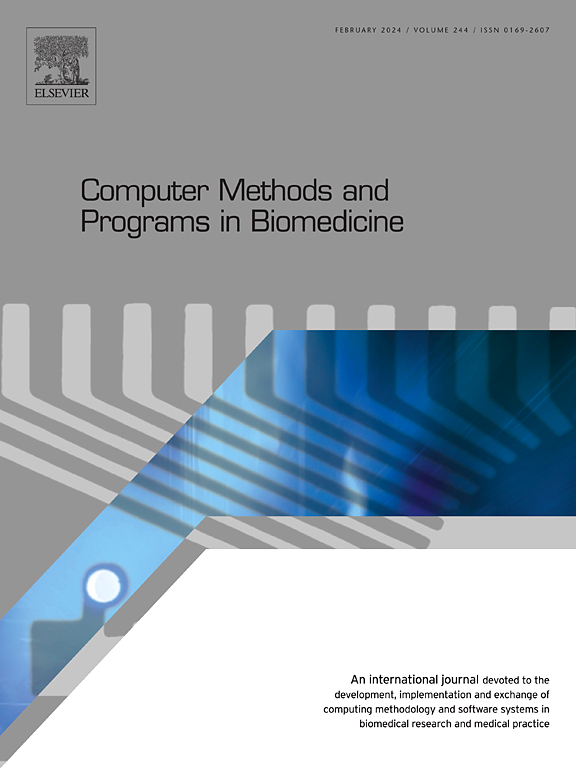基于动态自适应特征学习架构的代谢物-疾病关联预测
IF 4.9
2区 医学
Q1 COMPUTER SCIENCE, INTERDISCIPLINARY APPLICATIONS
引用次数: 0
摘要
背景与目的近年来,代谢物与复杂人类疾病之间的关系日益被认为是一个重要的研究热点。传统的湿实验室实验被认为是费时费力的,而计算方法已被证明可以显着提高研究效率。然而,现有的预测代谢物-疾病关联的方法主要依赖于预定义的相似性指标和静态网络结构,往往无法捕捉代谢物和疾病网络中节点邻域之间复杂的相互作用。这一限制阻碍了对代谢物和疾病之间更深层次动态关系的捕捉,导致信息丢失和噪声,从而降低预测性能。方法提出一种创新的动态自适应特征学习架构(DAF-LA)来预测代谢物与疾病的关联。该体系结构集成了动态子图构建和自适应特征增强机制,通过从初始到高阶特征表示的逐步优化,实现了高精度的特征学习和关联预测。结果对该体系结构进行5重交叉验证,AUC为0.9742,AUPR为0.9734。此外,案例研究表明,DAF-LA能够准确预测与阿尔茨海默病、2型糖尿病和帕金森病相关的代谢物。结论该方法通过动态拓扑建模和多尺度协作学习,有效揭示了代谢物与疾病之间的潜在关联。它可以更快地识别可能的代谢物-疾病关系,减少传统湿实验室实验中低效的大规模筛选所带来的时间和资源成本,并为后续的生物学验证提供更有针对性的指导。本文章由计算机程序翻译,如有差异,请以英文原文为准。
Predicting metabolite-disease associations based on dynamic adaptive feature learning architecture
Background and Objective
In recent years, the association between metabolites and complex human diseases has increasingly been recognized as a major research focus. Traditional wet-lab experiments are considered time-consuming and labor-intensive, while computational methods have been shown to significantly enhance research efficiency. However, existing methods for predicting metabolite-disease associations primarily depend on predefined similarity metrics and static network structures, often failing to capture the complex interactions among node neighborhoods within metabolite and disease networks. This limitation hinders the capture of deeper dynamic relationships between metabolites and diseases, resulting in information loss and noise that deteriorate prediction performance.
Methods
An innovative dynamic adaptive feature learning architecture (DAF-LA) is proposed to predict metabolite-disease associations. This architecture integrates dynamic subgraph construction and an adaptive feature enhancement mechanism, enabling high-precision feature learning and association prediction through progressive optimization from initial to high-order feature representations.
Results
The architecture was evaluated through five-fold cross-validation, achieving an AUC of 0.9742 and an AUPR of 0.9734. Additionally, the case study demonstrates that DAF-LA accurately predicts metabolites associated with Alzheimer's disease, Type 2 diabetes mellitus and Parkinson's disease.
Conclusions
The results demonstrate that our method effectively uncovers potential associations between metabolites and diseases through dynamic topological modeling and multi-scale collaborative learning. It enables faster identification of likely metabolite-disease relationships, reduces the time and resource costs associated with inefficient large-scale screening in traditional wet-lab experiments, and provides more targeted guidance for subsequent biological validation.
求助全文
通过发布文献求助,成功后即可免费获取论文全文。
去求助
来源期刊

Computer methods and programs in biomedicine
工程技术-工程:生物医学
CiteScore
12.30
自引率
6.60%
发文量
601
审稿时长
135 days
期刊介绍:
To encourage the development of formal computing methods, and their application in biomedical research and medical practice, by illustration of fundamental principles in biomedical informatics research; to stimulate basic research into application software design; to report the state of research of biomedical information processing projects; to report new computer methodologies applied in biomedical areas; the eventual distribution of demonstrable software to avoid duplication of effort; to provide a forum for discussion and improvement of existing software; to optimize contact between national organizations and regional user groups by promoting an international exchange of information on formal methods, standards and software in biomedicine.
Computer Methods and Programs in Biomedicine covers computing methodology and software systems derived from computing science for implementation in all aspects of biomedical research and medical practice. It is designed to serve: biochemists; biologists; geneticists; immunologists; neuroscientists; pharmacologists; toxicologists; clinicians; epidemiologists; psychiatrists; psychologists; cardiologists; chemists; (radio)physicists; computer scientists; programmers and systems analysts; biomedical, clinical, electrical and other engineers; teachers of medical informatics and users of educational software.
 求助内容:
求助内容: 应助结果提醒方式:
应助结果提醒方式:


